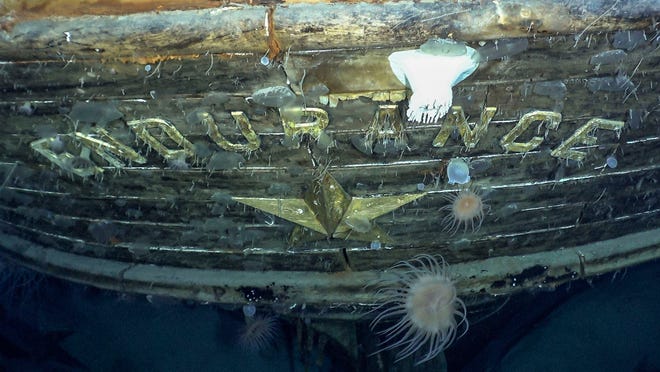NEWPORT, R.I. — Ryan Miller has an appreciation for history, which is part of the reason he and his wife purchased one of the oldest houses in the city of Newport.
What he didn’t expect to discover on the property is a cannonball likely used during the Revolutionary War.
“It was quite surprising,” Miller said. “We were kind of keeping our eye out for relics. I had done some metal detection before we started construction and stuff like that, but all I found was old nails. It was nice to find something cooler.”
Miller and his wife Monika, who have two children, bought the John Bliss House about three years ago. The farmhouse was built in 1680 by John Bliss on land deeded to him by his father-in-law, Rhode Island Gov. Benedict Arnold.
One of the Rhode Island’s last remaining stone-enders – a centuries-old architectural style in which one side of the house is made almost entirely of chimney stone. The Millers, who said they “love old houses” and “taking on a project,” have plans to construct a barn behind the house, and a contractor was excavating the yard on Aug. 26 when he noticed something in the dirt – a metal sphere partially covered in rust.
Miller contacted the Newport Historical Society, which referred him to the Naval War College Museum as well as the Varnum House Museum.
“I spoke with some of the historians, and they thought mostly like it was a solid shot, solid metal,” Miller explained. “But there was a slight chance it was a hollow shot that would have been filled with gunpowder.”
Mammoth Cave: Coke bottles, ticket stubs, pre-historic debris discovered in world’s longest-known cave system
Discovery: ‘Very distinct’ dinosaur tracks made 113 million years ago revealed by severe Texas drought
One of the ways to identify a hollow shot from a solid shot, Miller said, is a cap on the cannonball. If the cap is there, that means it’s a hollow shot. But on this one, rust was covering where the cap normally would be.
Not taking any chances, he called the police, who promptly arrived with a bomb squad.
“I was expecting to make an appointment, but things escalated quickly and 20 minutes later, Newport police was there blocking off the street and the bomb squad was two minutes behind them,” Miller said.
Members of the bomb squad took the cannonball to the basement of the house and used a portable X-ray machine to determine it was, in fact, a solid shot and not a hazard. That certainly was a relief for Miller and his family.
“This thing had been climate controlled for so long, and, with how hot it’s been, now I bring it up. I didn’t want to disturb it,” he said.
The discovery came nearly 244 years to the day since the Battle of Rhode Island on Aug. 29, 1778. Now Miller will work with the historians at the Varnum House Museum in an attempt to identify it.
The cannonball is 5.5 inches in diameter and 23 pounds, which “lines up with what the British had in Newport,” Miller said. American soldiers often used 18-pound shots, according to one of the historians to whom he spoke.
Miller added the John Bliss House was used as a field headquarters by the British during the war.
“This is what Newport is all about. This is why so many people live here — the cool history that’s in this town,” he said.
So what will he do with the cannonball? Likely display the historic artifact in his historic home.
“We plan on being here a long time, and it’s a piece of history to go with the house,” he said. “But I could see it being lent to the Newport Historical Society for an exhibit or something. I haven’t gotten that far. I don’t plan on selling it or anything like that. It’s an important piece of history.”
What’s everyone talking about?: Sign up for our trending newsletter to get the latest news of the day



